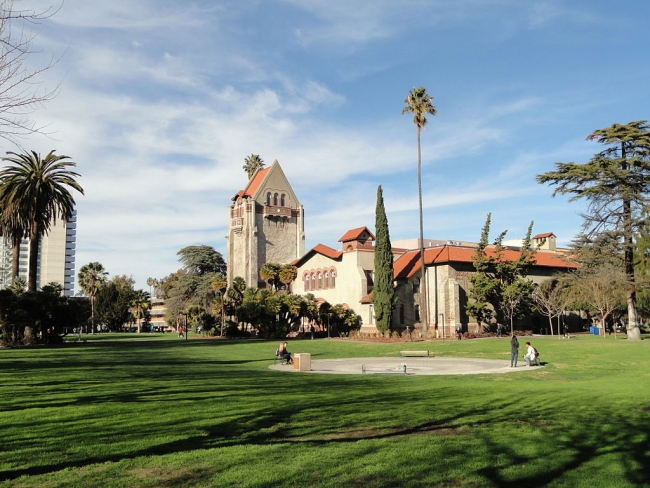You have /5 articles left.
Sign up for a free account or log in.

Wikimedia Commons
It seemed like nearly every college was putting out announcements in May about their fall reopening plans and betting mightily against the strength of the pandemic. Now several of those institutions have decided to stick to online instruction because of the growing rate of infection. Others have reopened their campuses, only to see a spate of outbreaks. As the number of cases grows on campuses across the country, leaders at institutions still planning to reopen are standing firm.
Administrators at a select few colleges saw things differently, however. They were aware that the virus could continue to surge; they chose not to gamble with the fall semester. Eastern Washington University announced on May 4 that the majority of its classes would be online. The chancellor of the California State University system followed suit on May 12 and announced that its 23 campuses would run most classes remotely. Both institutions plan to hold some labs and hands-on courses in person. Administrators at both colleges say their bets resulted in a few wins and a few losses, but over all they do not regret their decision to play it safe.
“It's always hard to be the leader in something like this, something people don’t want,” said David May, interim president of Eastern Washington, who was provost when the decision was made to keep instruction remote. “We got criticism from everybody. Students weren’t happy. Faculty weren’t happy initially.”
Nationally, students have made it abundantly clear on social media and in surveys that they do not want to learn online, and if they do, they expect to be paying much less in tuition and fees.
“We absolutely saw a lot of students walk away from Eastern Washington University because other universities were telling them that they were going to be face-to-face,” May said. “Students very rightly want the college experience, and they were told they could get it at different universities.”
But making the decision early, May said, gave the university time to make up for the lost enrollment.
Students weren't the only ones disappointed with the decision to keep instruction remote. May noted that many faculty members did not enjoy teaching online in the spring and were less than eager to repeat the experience. And local residents and businesses were also dismayed that there may be fewer students on campus to fuel the economy. (Eastern Washington is allowing students to choose whether they want to live on campus and is offering single rooms for those who do.)
“We had to do a lot of talking, have a lot of conversations and help people understand why we were making the decisions we were,” May said.
He said deciding early not to reopen this fall also gave the college time to run a series of weekly workshops to introduce faculty to technology available to them to help with online instruction.
“My friends in the faculty have said, ‘It’s just nice to have the summer to take what I did in that three-week period [in March] and make it a real class,’” May said.
At San José State University, part of the Cal State system, Provost Vincent Del Casino said the decision to put most classes online was anxiety-inducing.
“We had no idea of how students would respond. No one had a sense of what this would look like, and we didn’t know where everyone else was going to go,” he said. “When you make a decision really early, there’s the question of ‘How do you know what it’s going to look like in September or late August?’ And the truth was we didn’t.”
Fall enrollment at San José has hovered between 32,000 and 34,000 in the past few years, and Del Casino said the numbers have remained largely consistent, even as the number of international students has fallen. He said for all the talk of students not enrolling in remote programs, many have realized the drawbacks of delaying their education in the current economy and with fewer employment opportunities available.
The university also made a multimillion-dollar investment in faculty development with a summer remote learning training program for more than 1,000 faculty members. The university gave each trainee $1,000 to participate. (The president of the California Faculty Association, the union for professors at Cal State, said the organization expected members to be paid for any volunteer work done during the summer when their contract is not in effect.)
Cal State chancellor Timothy White echoed some of Del Casino’s sentiments about deciding early to stay remote this fall.
“If we're wrong, I can live with that mistake. But what I didn't want to do is have that yo-yo,” White said in a podcast appearance with the American Council on Education. “Yo-yo delivery of higher education is tough on faculty, tough on staff and tough as hell on students and their families.”
Cal State's early decision, he said, gave some other universities that had initially planned to be in-person license to follow suit and stick to remote learning.
“It took some courage to get out there, and we could have been wrong,” he said.
For many colleges, the threat of declining enrollment, tuition and fees is creating enormous pressure to reopen. But some observers have speculated that if more institutions had declared an online semester early on, a good deal of stress could have been avoided by all involved.
“If the decisions like Cal State made to go online had been made earlier, I think it would have changed our preparations to be a bit more fully online mind-set,” said Chuck Staben, former president and current professor at the University of Idaho.
Ultimately, leaders at both San José State and Eastern Washington say the benefits outweighed the drawbacks.
“Getting ahead of this early allowed us to have clarity of message and a simplicity with people with what it’s going to look like,” Del Casino said. “Knowing what we know now, we absolutely made the right decision.”
“Everybody was upset,” said May. “Until all the other colleges started following.”








